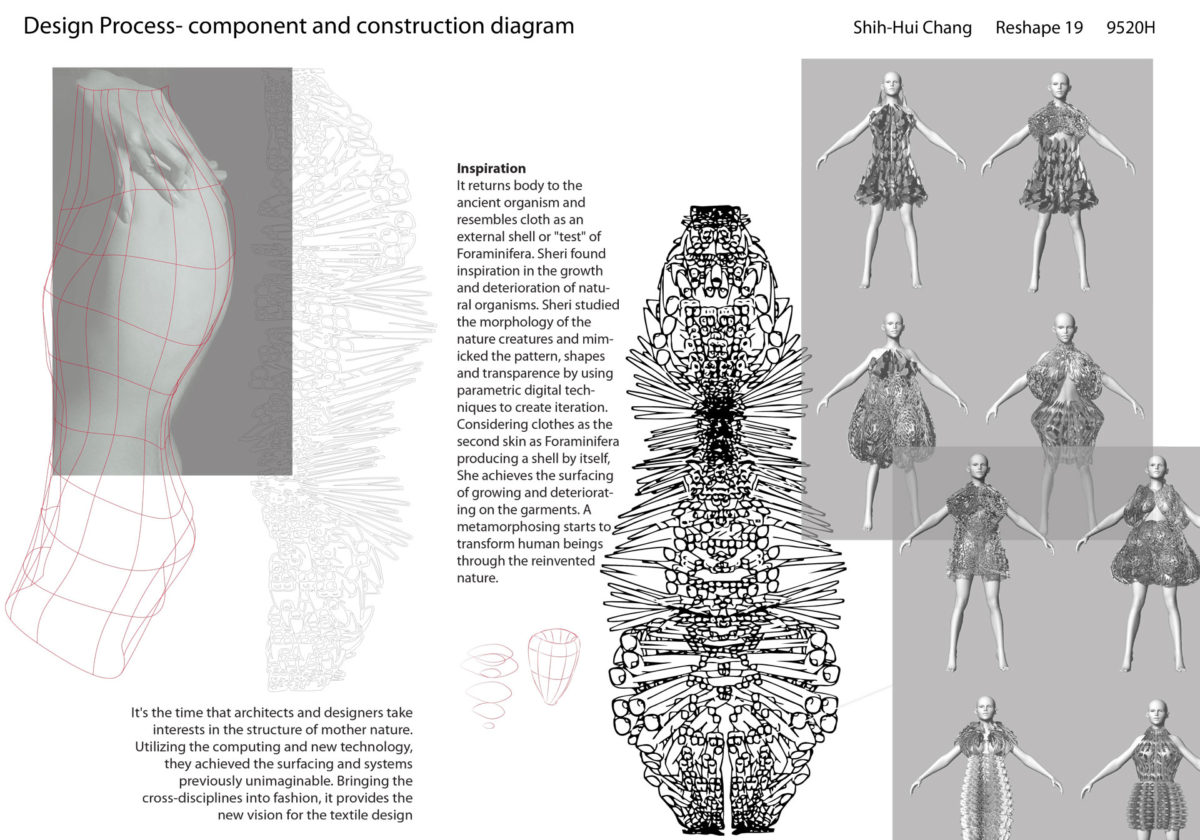RESHAPE19 | Cognified matter
Wearable Technology category
Digital Fabrication Biotextile

The product development of the garment involves interdisciplinary backgrounds. In 2015, I developed a methodology of bio-inspired fashion design by using digital fabrication technique and parametric digital technique, which generated garment designs in various looks in Rhino. I then started to fabricate and experimented with new materials ever since. The research results in a brand new understanding of aesthetics, fabricating process, and materials that present my vision of fashion in future: a combination of digital design bases on the form of a human figure and digital manufacturing by the machines. Biomaterials create a second skin for humans. And, aesthetically, people appreciate the skin patterns that various creatures manifest. Biomimicry transforms clothes into shells and cocoons like garments that both reminds us of the beauty of nature and serves as a protection.
The process began with a working surface that sketches the silhouette of a human figure in the software. The second step is using parametric digital techniques to create iterations of pattern and form. I found inspiration in the growth and deterioration of natural organisms—particularly looking at the morphology of skins. I created a series of digital files that contained both the garment patterns and the digitally derived 3D forms. I then used laser cutting, 3D printing, and CNC routing to create both the garment patterns, graphic patterns, and 3D molds for casting many of my pieces. This casting biomaterial — a mixture of gelatin, sorbitol, glycerin, and zinc oxide — looks and performs close to silicone rubber. This castable material is then poured into the CNC molds. Thus, a mixture of the food-grade material is transformed into an organic fabric.

The research of the project aims to provide a solution of design and fabrication for the industry and offer an alternative material for textile. The current fashion industry is usually subjected to environmental and economic crises. The problems include pollution (from dying and producing fabric) and waste (from fast fashion), the difficulty of finding local workers work in the traditional garment factories, and an enormous amount of carbon footprint generated from outsourcing to cheaper resources and labor for mass production. By comparison, this project utilizes food waste and materials derived from plants, and it also included the recipe of bioplastic. It is a proposal of eco-friendly alternative material for the industry, turning the low-cost leftover material into economic values. For example, gelatin is derived from collagen taken from animal body parts, and it’s made primarily from the leftover of meat industries; Sobitol is from potato starch and widely used in the cosmetic industry. The mixture of the organic material is flexible, easy to dye with food coloring and plants, castable, and fast cure (20 mins for demold) for producing a large piece of fabric. Combining with the methodology of digital design and fabricating, the innovative and environmentally friendly production can attract young professionals, researchers, and artists to collaborate and rejoin the fabricating process, giving fresh energy to the traditional industry. In this aspect, it can solve the issues of “racing to the bottom”: the companies are forced to outsource to cheaper labor and resources. In this way, the industry can invest in the local economy, increase the value of human capital, and transform the future development.
The goal of the project also aims to encourage more research into local materials by investigating local plants, the culture of food, and traditional practices of crafting, so researchers can incorporate biopolymer and cellulose that are in the local environment into research topics. The sustainable economy can happen when the local knowledge can be recognized and developed into the product that reflects the heritage in their society.


